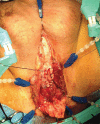Perineostomy: the last oportunity
- PMID: 25928514
- PMCID: PMC4752061
- DOI: 10.1590/S1677-5538.IBJU.2015.01.13
Perineostomy: the last oportunity
Abstract
Objective: To review the technique and outcome of perineal urethrostomy or urethral perineostomy and to identify factors related to the procedure failure.
Material and methods: We studied 17 patients who underwent perineal urethrostomy between 2009-2013 in a single hospital. Success was defined as no need for additional surgical treatment or urethral dilatation. We reviewed the clinical data related to age, weight, previous urethral surgery, diabetes, hypertension, ischemic cardiopathy, lichen sclerosus and other causes and studied their association with the procedure failure (univariate analysis). We completed the analysis with a multivariate test based on binary regression.
Results: The average follow-up was 39.41 months. From all the causes, we found Lichen Sclerosus in 35 %, idiopathic etiology in 29 % and prior hypospadia repair in 18 %. Postoperative failure occurred in 3 patients, with a final success of 82.4 %. The binary regression model showed as independent risk factors ischemic cardiopathy (OR: 2.34), and the presence of Lichen Sclerosis (OR: 3.21).
Conclusions: The success rate with the perineal urethrostomy technique shows it to be a valid option above all when we preserve the urethral blood supply and plate. Lichen sclerosus and ischemic vascular problems are risk factors to re-stenosis.
Conflict of interest statement
None declared.
Figures
References
-
- Kulkarni S, Barbagli G, Sansalone S, Lazzeri M. One-sided anterior urethroplasty: a new dorsal onlay graft technique. BJU Int. 2009;104:1150–1155. - PubMed
-
- Pugliese JM, Morey AF, Peterson AC. Lichen sclerosus: review of the literature and current recommendations for management. J Urol. 2007;178:2268–2276. - PubMed
-
- Barbagli G, Selli C, Tosto A. Reoperative surgery for recurrent strictures of the penile and bulbous urethra. J Urol. 1996;156:76–77. - PubMed
-
- Barbagli G, Angelis M, Palminteri E, Lazzeri M. Failed hypospadias repair presenting in adults. Eur Urol. 2006;49:887–894. discussion 895. - PubMed
-
- Elliott SP, McAninch JW, Chi T, Doyle SM, Master VA. Management of severe urethral complications of prostate cancer therapy. J Urol. 2006;176:2508–2513. - PubMed
MeSH terms
LinkOut - more resources
Full Text Sources
Other Literature Sources
Medical




